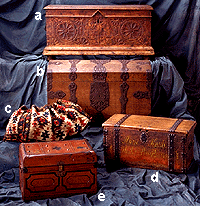
Travel Luggage
 |
a - Chest, ca. 1650; France; brought to Canada ca. 1650; Corsican pine, carved; 138 x 57 x 69.5 cm. CMC 78-181 These pieces of luggage represent three major waves of European immigration to Canada over a period of four hundred years. The topmost chest arrived with immigrants who left France in the seventeenth century. Of north-German origin, the iron-bound chest immediately below came, not directly from Europe, but from the United States with the flood of British Loyalists and other groups who settled in Ontario and the Maritimes after the American Revolution. Among them were large numbers of Pennsylvania Germans, one of whom owned this chest. The Russian Doukhobor carpetbag arrived with the third large influx of settlers, following the opening of the Canadian West in the 1870s. Typical of the Transcaucasian region of the Tsarist Empire, the bag was normally used to hold bedding and other household goods. The Norwegian trunk at lower right was originally brought to Minnesota, but ultimately travelled to Saskatchewan with one of the 300,000 midwestern Americans seeking cheap land in the Canadian West. A more unusual and poignant group of immigrants were the 8,000 orphans and homeless children sent out from England and placed in Canadian homes between 1882 and 1895 by the humanitarian Dr. Thomas John Barnardo. They set out with their scant belongings packed in small metal trunks like the one at lower left. |
